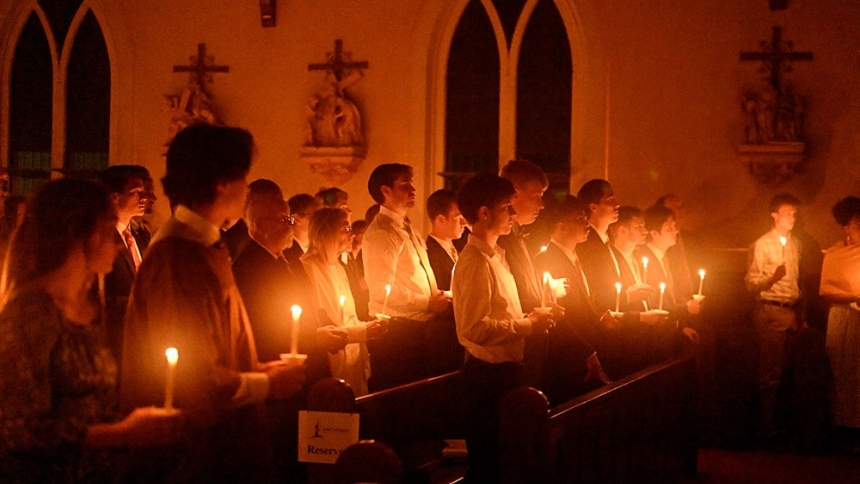
Have you ever been to the Easter Vigil? Will you go this Saturday evening? You really should consider it, suggests Richard Budd, Director of the Office of Marriage & Family for the Diocese of Lansing, in the following article. Richard writes:
Season four of the massive hit series The Chosen was recently released. If you haven’t had the chance to watch it, I highly recommend binging the entire thing. It is one of the most well-done depictions of the life and ministry of Jesus told from the apostles' perspective. You might think this is high praise considering the many great depictions in such movies as The Passion of the Christ, and the classic Jesus of Nazareth, but I assure you, it lives up to the hype.
The story of Jesus has been told and retold countless times during the two millennia since he walked the earth. It is a story rich in mystery, amazement, surprise and drama. We can’t help but return to it again and again, particularly during Lent, when the readings at Mass and, most especially during Holy Week, are filled with such complex and interesting characters. Pilate, Simon Peter, Judas, Caiaphas, the high priest, Simon of Cyrene, and Mary, Christ’s mother, are highly dramatic characters bringing their multifaceted stories to this moment, whereupon the future of all human history hinges.
Of all the characters that make up this story, I am fascinated by the role Mary Magdalene plays. If you remember, the Gospel tells us that Jesus drove out seven demons from her, and she became one of his closest disciples. She was more courageous than almost all Jesus’ male followers, as she was among the women who accompanied Jesus to the end at the foot of the cross and, as we hear in John’s Gospel, was so eager to care for his body after he died, she rose in the darkness and went to the tomb to finish the burial rituals they didn’t have time to complete Friday. It’s to her that Jesus first reveals his resurrection from the dead, and then sends her to the other disciples as the first evangelist, even though Jewish law generally did not treat the testimony of women as valid. Mary Magdalene is a witness of God's great love for us — which we are to return to him.
Sometimes, the high drama of this story can escape us, either because we’ve become very familiar with the story or because we usually get it in such small installments over the course of many Masses. However, there is one way we can experience the depth and richness of what God has done for us from the first moments of “In the beginning” to his glorious revelation to Mary Magdalene, and that is at the Easter Vigil Mass.
The Easter Vigil is the Mass that occurs the night before Easter Sunday. It starts after sundown in the dark, while we await our Lord’s victory over the grave.
Unlike most Masses, which begin with the priest in the sanctuary at the front of the church, this Mass begins outside around a bonfire, with the blessing of the giant Easter candle you’ve probably seen next to the baptismal font in your church. From there, the participants process into the pitch-dark church, following the lone flame of Christ. The poignancy of this moment is unmistakable. Sometimes, in this life, we can feel surrounded by darkness. It disorients us and causes us to be unsure of where we’re going. We might shuffle our feet out of an instinctive caution to not trip over something we can’t see or have trouble finding the pew we were in. And if it weren’t for that lumen Christi, the light of Christ, we’d be lost.
But then, the light begins to spread. Each baptized person takes a small flame from the light of Christ, and in very short order, the whole church is alive with candlelight. We see what life could be like if we all embraced the light of Christ, each of us sharing that light with his neighbor and each enlightening the path of the other. We relax, and the feeling of unease dissipates.
When the service of light is concluded, we hear an accounting of the great story: how God created us in love, but we rejected it, preferring ourselves to his love. He continually pursued us through the great patriarchs, Moses and the prophets, until, at last, God came to us in his son. The Gloria, initially sung by the angels on Christmas night, is sung, all the bells of the church are rung, the candles are lit, and it is impressed upon us what a difference Jesus makes by his arrival in our midst. We sing the Great Alleluia and then hear the account of the resurrection from the dead. The whole drama of our salvation is proclaimed in one Mass.
Afterward, people preparing to enter the Church have this drama played out by stepping forward to the baptismal font. There, they receive the death and rising of Christ into their own lives. Each of us gets the chance to renew our baptismal promises and recommit to the relationship of love we have been hearing and witnessing all evening. Then, these new Christians receive the Holy Spirit as he rushes upon them in the sacrament of confirmation. Finally, they receive him, body, blood, soul and divinity in their first Holy Communion.
The Easter Vigil is the vigil of vigils, the night of nights — the whole drama of human history is played out before us, and we get to participate, just like Mary Magdalene. Like her, we arrive while it is dark to be the first witnesses to the resurrection. We aren’t passively engaging with the story on a screen — through the mystery of the liturgy, we’re being drawn up into it, becoming part of the great drama as it becomes part of us.
This year, especially if you’ve never been, go to the Easter Vigil.
* First published in FAITH Magazine, March 2024.
